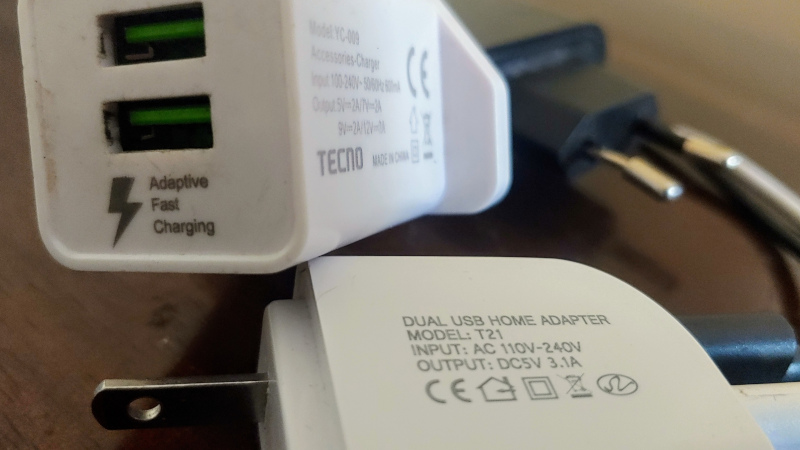I never really hopped onto the fast-charging bandwagon. I just felt that if a phone had good enough battery life it didn’t matter how fast one could top it up. I was impressed by the eight minute top up Xiaomi demoed though.
That attitude came from the priviledge of having access to a power outlet whenever needed. These latest power cuts have changed that.
While researching the best charger for my devices, I realized that a lot of misinformation is floating out there. Let’s toss the chaff and see what remains.
Quick O’Level Physics Recap
Remember: Watts = Amps x Volts
Unfortunately, there is no way around getting a little acquainted with our old pals – watts, amps, and volts. Watts = Power (total charge) and this power is the amount of electricity flowing (Amps/current) multiplied by the strength of the current (Volts.)
Fast chargers vary either amps or voltage or both to enable a faster top up.
The device
You will find that device specifications usually mention the total wattage a device can handle. My phone for example can handle a meagre maximum of 18W using the Qualcomm Quick Charge 3.0 standard.
So, first, check if your device does support fast charging, the maximum wattage it can handle and the fast charging standard it supports. We won’t go into overviews of the standards to save time.
The charger
Chargers on the other hand talk about volts and amps. Quick maths will determine whether a charger can deliver the maximum wattage your device can handle.
For my phone, the TECNO charger below can do that – 9*2 (18W.) The other one caps off at 15.5W.
We are not out of the woods yet. There are different fast charging standards with different power management chips and protocols so you can’t grab any power brick that pumps out your required wattage.
Some standards are compatible with others so you can mix and match in those cases. We won’t go into all that.
In my case, although both chargers can deliver upwards of 15W , with the TECNO delivering the maximum my phone can handle, neither come close to that in practice.
I have no idea which standard the first one is using and the TECNO claims to use Adaptive Fast Charging. Neither is compatible with my Quick Charge 3.0 toting phone.
Computer USB Ports
The standard voltage on USB ports is 5V.
USB 1.0 and 2.0 deliver up to 0.5A (500mA) and so a maximum of 2.5W. That’s why recharging via the port of an old computer is so slow.
USB 3.0 bumps the amperage up to a maximum of 0.9A translating to 4.5W.
Note that these specs are for ports on computers, dedicated chargers can beat these amperage figures.
The cable
Get one that supports your device’s fast charging standard. People usually assume the brick does all the lifting. Don’t be people. Don’t let your fancy fast charger be underutilized because of a hand-me-down cable.
How do you know the charger is fast charging?
Some phones will indicate, making it easy. Some will display text on the lock screen and some will utilize double lightning bolts in the status bar for example. If you can’t find this indication you can use an app like Ampere.
The first screenshot is when the phone is disconnected, the second is when it is plugged into a USB 2.0 port and the third is when plugged into one of the chargers pictured earlier, they perform the same.
Time for calculations: Note that for amps we add the discharging amperage to the charging amperage. Also, 1000mA = 1A, so 500mA = 0.5A for example.
Using the USB port I’m getting 4.272V * [(170+280)/1000A] = 1.92W. Paltry.
Using the chargers: 4.341V * [(170+1000)/1000A] = 5.01W. Still paltry. I could be topping up at 18W.
Conclusion
The three point checklist :
- Which fast charging standard does my phone support?
- Does adapter/ charging brick support the same standard?
- Does cable support same standard?
The math is only needed when you can’t find a certified charger from your device’s manufacturer. Then it might be mix and match time.
What if the charger is rated for higher power delivery than my phone? Won’t that fry my phone?
It doesn’t matter if the charger supports higher wattage than your phone. For example the TELCO above can deliver 24W (12*2), higher than the 18W my phone supports. The phone will take what it can handle and not a watt more.
Of the three components – phone, charger and cable – the weakest link will determine the charging speed. Plugging in your old smartphone or kambudzi into a fast charger is an exercise in futility.

Comments
One response
I do hope when you do your next phone review after doing a battery drain test you also do recharging times.
Out of interest sake, can you do itel p37 pro and p37 pro recharging times because the latter doesn’t support fast charging.